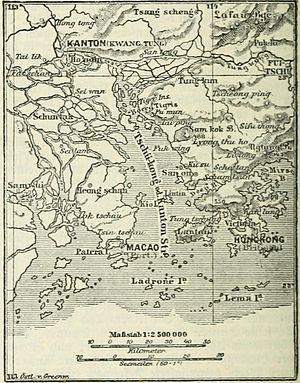Macau Incident (1799)
| Macau Incident | |||||||
|---|---|---|---|---|---|---|---|
| Part of the French Revolutionary Wars | |||||||
 Map of the mouth of the Pearl River. The Wanshan Archipelago labelled "Ladrone In". |
|||||||
|
|||||||
| Belligerents | |||||||
|
|
|
||||||
| Commanders and leaders | |||||||
| Captain William Hargood | Rear-Admiral Ignacio Maria de Álava | ||||||
| Strength | |||||||
| Two ships of the line, one frigate | Two ships of the line, four frigates | ||||||
| Casualties and losses | |||||||
| None | None | ||||||
The Macau Incident was an inconclusive encounter between a powerful squadron of French and Spanish warships and a British Royal Navy escort squadron in the Wanshan Archipelago (or Ladrones Archipelago) off Macau on 27 January 1799. The incident took place in the context of the East Indies campaign of the French Revolutionary Wars, the allied squadron attempting to disrupt a valuable British merchant convoy due to sail from Qing Dynasty China. This was the second such attempt in three years; at the Bali Strait Incident of 1797 a French frigate squadron had been driven off during an attack on that year's China convoy. By early 1799 the French squadron had dispersed, with two remaining ships deployed to the Spanish Philippines. There the frigates had united with the Spanish Manila squadron and sailed to attack the British China convoy gathering at Macau.
The British commander in the East Indies, Rear-Admiral Peter Rainier was concerned about the vulnerability of the China convoy and sent reinforcements to support the lone Royal Navy escort, the ship of the line HMS Intrepid under Captain William Hargood. These reinforcements arrived on 21 January, only six days before the allied squadron arrived off Macau. Hargood sailed to meet the French and Spanish ships, and a chase ensued through the Wanshan Archipelago before contact was lost. Both sides subsequently claimed that the other had refused battle, although it was the allied squadron which withdrew, Hargood later successfully escorting the China convoy safely westwards.
The East Indian trade was an essential component of the economy of Great Britain in the eighteenth century. Administered by the East India Company from British India, exotic trade goods were carried on large well-armed merchant ships known as East Indiamen, which weighed between 500 and 1,200 long tons (510 and 1,220 t). Among the most valuable parts of the East India trade was an annual convoy from Macau, a Portuguese port in Qing Dynasty China. Early each year, a large convoy of East Indiamen would assemble at Macau in preparation for their six-month journey across the Indian Ocean and through the Atlantic to Britain. The value of the trade carried in this convoy, nicknamed the "China Fleet", was enormous: one convoy in 1804 was reported to be carrying goods worth over £8 million in contemporary values (the equivalent of £600,000,000 as of 2017).
...
Wikipedia
